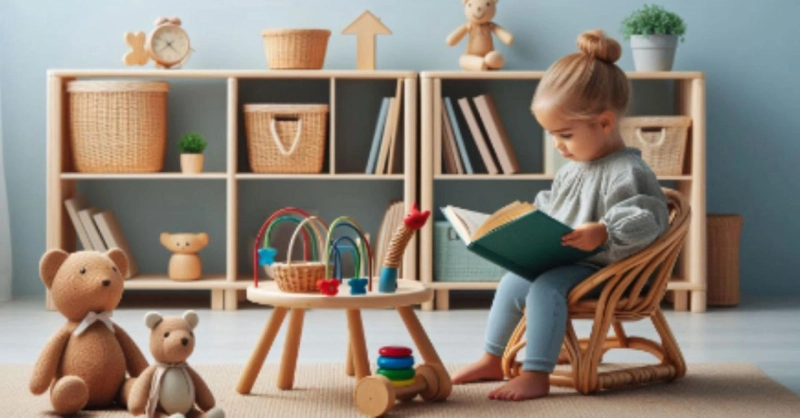Rattan toys and furniture have been gaining popularity among parents and educators for their numerous benefits in early childhood development. Made from natural materials, rattan products are not only eco-friendly but also offer unique advantages that support the cognitive, physical, and emotional growth of young children. This article explores the educational benefits of incorporating rattan toys and furniture into early childhood environments.
Educational Benefits of Rattan Toys and Furniture in Early Childhood Development
The choice of toys and furniture plays a pivotal role in early childhood development. Rattan toys and furniture, with their natural charm and numerous developmental benefits, offer a unique and enriching experience for young children and support their growth in multifaceted ways.
Promoting Sensory Development
Rattan toys and furniture provide rich sensory experiences for young children. The natural texture of rattan engages the sense of touch, allowing children to explore different surfaces. This tactile stimulation is crucial for the development of fine motor skills and sensory processing abilities. By interacting with rattan items, children learn to differentiate between textures, enhancing their sensory perception and integration.
Encouraging Imaginative Play
One of the significant benefits of rattan toys is their versatility in imaginative play. Unlike plastic toys that often come with predefined functions, rattan toys are open-ended and can be used in various ways. For example, a rattan basket can transform into a treasure chest, a doll’s bed, or a vehicle in a child’s imaginative world. This type of play encourages creativity, problem-solving, and cognitive flexibility, essential skills for early childhood development.
Supporting Physical Development
Rattan furniture, such as chairs, tables, and storage units, is designed to be child-friendly and ergonomic. These pieces support proper posture and physical development. Rattan rocking chairs, for instance, help develop core strength and balance as children rock back and forth. Additionally, the lightweight nature of rattan furniture allows children to move and arrange pieces themselves, promoting independence and gross motor skills.
Enhancing Environmental Awareness
Using rattan toys and furniture instils a sense of environmental responsibility in young children. Rattan is a sustainable material that grows quickly and requires minimal processing. Introducing children to eco-friendly products helps them understand the importance of sustainability and encourages environmentally conscious behaviours. This early exposure to sustainable practices can shape their attitudes toward the environment in the long term.
Providing a Calming Aesthetic
The natural appearance of rattan contributes to a calming and aesthetically pleasing environment. This soothing atmosphere can have a positive impact on children’s emotional well-being. A calm environment helps reduce stress and anxiety, making it easier for children to focus and engage in learning activities. The neutral tones of rattan also complement various interior styles, creating a harmonious and inviting space for children.
Fostering Social Interaction
Rattan toys and furniture can facilitate social interaction among children. Items such as rattan play kitchens, tea sets, and dollhouses encourage collaborative play, where children engage with peers in shared activities. This social interaction is vital for developing communication skills, empathy, and cooperation. Through role-playing and group play, children learn to navigate social dynamics and build meaningful relationships.
Promoting Cultural Awareness
Rattan has cultural significance in many parts of the world, particularly in regions where it is traditionally used for crafting furniture and household items. Introducing rattan toys and furniture like children bookshelves to children can be an educational opportunity to explore different cultures and traditions. This exposure fosters cultural awareness and appreciation, broadening children’s understanding of the world around them.
Encouraging Responsibility and Care
Caring for rattan toys and furniture teaches children responsibility. Since rattan items require gentle handling and regular maintenance to preserve their condition, children learn to take care of their belongings. This sense of responsibility extends to other areas of their lives, promoting a respectful attitude towards personal and shared property.
Enhancing Learning Environments
Rattan furniture can be an excellent addition to educational settings, such as classrooms and daycare centres. Its durability and versatility make it suitable for various activities, from reading corners to art stations. The natural aesthetic of rattan creates a warm and inviting learning environment conducive to concentration and engagement.
Stimulating Cognitive Development
Rattan toys often feature intricate patterns and designs, which can stimulate cognitive development in young children. These patterns can help children recognize shapes, improve their visual discrimination skills, and enhance their attention to detail. Moreover, interacting with rattan toys requires children to engage in activities such as sorting, stacking, and organizing, which are crucial for developing problem-solving skills, logical thinking, and spatial awareness.
To conclude all
Incorporating rattan toys and furniture into early childhood settings offers numerous educational benefits. From promoting sensory and physical development to fostering social interaction and environmental awareness, rattan products support holistic growth in young children. By choosing rattan, parents and educators can create enriching environments that nurture the development of essential skills and values in early childhood.


